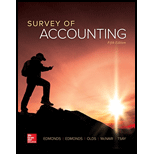
Concept explainers
Problem 10-20A Using the payback period and unadjusted
Seth Fitch owns a small retail ice cream parlor. He is considering expanding the business and has identified two attractive alternatives. One involves purchasing a machine that would enable Mr. Fitch to offer frozen yogurt to customers. The machine would cost $16,200 and has an expected useful life of three years with no salvage value. Additional annual cash revenues and cash operating expenses associated with selling yogurt are expected to be $12,400 and $1,800, respectively.
Alternatively, Mr. Fitch could purchase for $20,160 the equipment necessary to serve cappuccino. That equipment has an expected useful life of four years and no salvage value. Additional annual cash revenues and cash operating expenses associated with selling cappuccino are expected to be $17,000 and $4,860, respectively.
Income before taxes earned by the ice cream parlor is taxed at an effective rate of 20 percent.
Required
Round your figures, including percentage rates, to two decimal points.
- a. Determine the payback period and unadjusted rate of
return (use average investment ) for each alternative. - b. Indicate which investment alternative you would recommend. Explain your choice.
a.
Ascertain the payback period and unadjusted rate of return (use average investment) for each alternative.
Explanation of Solution
The annual rate of return method:
The annual rate of return is the amount of income which is earned over the life of the investment. It is used to measure the annual income as a percent of the annual investment of the business, and it is also known as the accounting rate of return.
Payback period:
Payback period is the expected time period which is required to recover the cost of investment. It is one of the capital investment method used by the management to evaluate the proposal of long-term investment (fixed assets) of the business.
Ascertain the payback period for each alternative as follows:
Alternative 1:
Alternative 2:
Ascertain the unadjusted rate of return for each alternative as follows:
Alternative 1:
Alternative 2:
Working note:
Calculate the amount of cash flow per year for both alternatives:
| Particulars | Alternative 1 | Alternative 2 |
| Cash revenue | $12,400 | $17,000 |
| Less: Operating expense | 1,800 | 4,860 |
| Depreciation expense | 5,400(4) | 5,040(5) |
| Income before tax | 5,200 | 7,100 |
| Income tax expense | 1,040 (2) | 1,420 (3) |
| Net Income | 4,160 | 5,680 |
| Add: Depreciation expense | 5,400 | 5,040 |
| Cash flow per year | $9,560 | $10,720 |
Table (1)
(1)
Calculate the amount of income tax expense for alternative 1:
(2)
Calculate the amount of income tax expense for alternative 2:
(3)
Calculate the amount of depreciation expense for alternative 1:
(4)
Calculate the amount of depreciation expense for alternative 2:
(5)
b.
Indicate the investment alternative that is recommendable and explain the reason behind it.
Explanation of Solution
Indicate the investment alternative that is recommendable and explain the reason behind it as follows:
From the above calculation it is clear that alternative 2 appears better than alternative 1. This is because alternative 2 has a longer useful life and higher unadjusted rate of return, while alternative 1 has a shorter useful life and shorter unadjusted rate of return.
If the investor prefers shorter payback period then the investor can go for alternative 1 since it provide a quicker payback than alternative 2.
Want to see more full solutions like this?
Chapter 16 Solutions
Survey Of Accounting
- Financial accountingarrow_forwardThe gross margin ratio for Coastal Electronics this quarter is 40.07%arrow_forwardReeves Contractors has a beginning retained earnings balance of $425,800. For the year, the company earned a net income of $32,600 and paid dividends of $19,700. The company also issued $45,000 worth of new stock. What is the value of the retained earnings account at the end of the year?arrow_forward
- Hello tutor please given General accounting question answer do fast and properly explain all answerarrow_forwardA firm has a total book value of equity of $840,000, a market-to-book ratio of one-half, and a book value per share of $12. What is the total market value of the firm's equity? a. $130,000 b. $37,5000 c. $112,500 d. $200,000 e. $420,000 MCQarrow_forwardPlease provide the correct solution to this financial accounting question using valid principles.arrow_forward
 Managerial AccountingAccountingISBN:9781337912020Author:Carl Warren, Ph.d. Cma William B. TaylerPublisher:South-Western College Pub
Managerial AccountingAccountingISBN:9781337912020Author:Carl Warren, Ph.d. Cma William B. TaylerPublisher:South-Western College Pub
